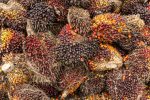
🌿 What is BHA?
- Chemical structure: BHA is a synthetic antioxidant made from a mixture of two phenolic isomers: tert-butyl-4-hydroxyanisole and tert-butyl-3-hydroxyanisole. The latter is 90% of the mixture.
- MW: 180.24, melting point 48-55ºC, boiling point 264-270ºC.
- Purpose: It is primarily used to prevent fats and oils in food from oxidizing — a process that causes rancidity, off-flavours, and spoilage. If you want to know a great deal more about BHA why not consult work by Zhang et al., (2023).
- History: It was developed as a new and effective antioxidant for fats in the 1940s. It is only soluble in fats and was immediately identified as a powerful functional ingredient for protecting fats such as tallow and lard from oxidation (Kraybill et al., 1949).
🍽️ Uses in food
An antioxidant that is especially effective in oils such as palm kernel and coconut oil although a number of other oils are very well protected especially by this antioxidant alone. It is is used in a variety of foods which use oils such as ice-creams for example.
-
Cheese:
- Added to processed cheeses to extend shelf life by slowing fat oxidation.
- Works particularly well in cheese spreads and slices containing emulsifiers and fats.
-
Meat:
- Used in sausages, dried meats, and preserved products to prevent oxidative rancidity.
- Often combined with BHT (Butylated Hydroxytoluene) or other antioxidants.
-
Baked goods:
- Added to pastries, cakes, and cookies to protect fats like butter, margarine, and shortening from breaking down.
- Especially useful in shelf-stable goods where fats sit for long periods.
-
Snacks:
- Found in crisps, popcorn, and cereal bars — anywhere with high-fat content prone to oxidation.
- Used in conjunction with packaging materials by coating the packaging interior to prevent direct addition to the food.
- Packaging:
-
- Used in a variety of packaging materials by either being directly added to the waxes that make up waxed inner liners or applied as an emulsion to inner surfaces. Good for wrapping meats.
🧪 Why use BHA in cheese?
Cheese, especially processed and spreadable types, contains fats and oils that are prone to oxidation. When these fats react with oxygen, they produce free radicals — unstable molecules that start a chain reaction, leading to:
- Rancidity — causing off-flavours and unpleasant smells.
- Discolouration — a yellow or brown hue may develop.
- Nutrient loss — certain vitamins (like A and E) degrade during oxidation.
BHA helps by interrupting the oxidation process and extending the cheese’s shelf life.
🧪 How is it measured?
- HPLC (High-Performance Liquid Chromatography): The most common method for quantifying BHA levels in food, separating it from other compounds.
- Spectrophotometry: Measures BHA’s absorbance after reaction with a colorimetric reagent.
- Gas Chromatography (GC): Sometimes used for fatty food matrices to separate and detect antioxidant residues.
🔬 Chemical reactions
- BHA works by donating a hydrogen atom from its phenolic group, neutralizing free radicals that trigger oxidative chains.
- It forms a stable phenoxy radical, stopping further oxidation of fats and oils.
- Often combined with chelating agents (like citric acid) to enhance its effect by reducing metal ion catalysts.
👅 Aftertaste and sensory effects
- BHA can produce a slightly medicinal or phenolic taste at high levels, especially if used without complementary flavour-masking agents.
- In snacks or baked goods, manufacturers carefully balance BHA levels to avoid noticeable off-flavours.
- Synergistic use: Often blended with BHT, tocopherols (Vitamin E), or ascorbic acid to minimize taste impact while boosting antioxidant power.
📊 Permissible levels
- BHA is usually kept below 200 ppm of fat or oil content, but the specific limit depends on the product type:
- Meats: 150–200 ppm
- Cheese spreads: 100–200 ppm
- Snacks: often around 50–100 ppm
🔬 How does BHA work chemically?
BHA acts as a free radical scavenger. Here’s the basic process:
- Initiation: Fat molecules (lipids) react with oxygen, forming lipid radicals (R•).
- Propagation: Lipid radicals react with more oxygen, forming peroxyl radicals (ROO•), which further attack other fat molecules, continuing the chain reaction.
- Termination (where BHA steps in):
- BHA donates a hydrogen atom (H) from its phenol group (–OH).
- This stabilizes the free radicals, stopping the oxidation chain.
- BHA itself becomes a BHA radical — but it’s stable enough to not react further.
The key reaction looks like this:
ROO•+BHA→ROOH+BHA•ROO• + BHA → ROOH + BHA•
The result? The ROO• radical turns into a non-reactive hydroperoxide (ROOH), breaking the chain.
🏷️ Where is BHA used in cheese?
It is most effective in processed cheeses because:
- They contain added fats (like butter or vegetable oils) that are vulnerable to oxidation.
- The emulsifiers used to create smooth textures also expose fats to air.
- Soft, spreadable cheeses have more surface area for oxygen to interact with.
Hard cheeses (like Parmesan or aged Cheddar) rely less on BHA because their lower moisture and fat content slows oxidation naturally.
⚖️ Permitted levels
BHA levels in food are typically regulated — the European Food Safety Authority (EFSA), FDA, and other bodies set maximum allowable concentrations.
- EU regulations: Up to 200 mg/kg in fat content using the EFSA limit with lower limits for meat and other processed foods.
- FDA: Has had GRAS status for many years. Max 0.02% (200 ppm) of a food including a cheese’s total fat weight.
- Typically, manufacturers use less than the max limit to avoid sensory issues.
The Safety of BHA
The Joint FAO/WHO Expert Committee on Food Additives has evaluated the safety of BHA many times from 1961, and the latest acceptable daily intake is set at 0-0.5 mg/kg body weight (Petri et al., 2008)
The effects of BHA on health and metabolism in mammals has been well researched (Iverson, 1995; Whysner & Williams, 1996; Williams et al., 1999). Safety has been reviewed in a number of animal models where it has been added as an animal feed additive Rychen et al., (2018), specifically in cats (Bampidis et al., 2021).
The picture on BHA has been largely confusing! It is certainly an antioxidant but in some circles when added in too high a concentration works as a prooxidant. As an antioxidant it thus can be seen as an anticarcinogen but it also acts as a carcinogen. In some models it acts as a tumour promoter and in others as a tumour inhibitor.
👅 Any impact on flavour?
At appropriate levels, BHA doesn’t produce a strong taste, but:
- Overuse can cause a slight medicinal, phenolic aftertaste.
- It’s often combined with other antioxidants (like BHT or citric acid) to reduce flavour impact while enhancing shelf life.
🧪 How does BHA interact with emulsifiers?
-
Fat distribution and antioxidant access:
- Emulsifiers break fat into small droplets surrounded by a water layer.
- This increases the surface area of fats exposed to oxygen — speeding up oxidation.
- BHA dissolves in the fat phase, positioning itself at the fat-water interface, where oxidation starts — so the more emulsified the fat, the more BHA is needed.
-
Synergistic effects with emulsifiers:
- Certain emulsifiers (like citric acid esters) can chelate metal ions (like iron or copper), which catalyze oxidation.
- BHA works better when paired with these emulsifiers, as metal ions are “locked away,” giving BHA a chance to neutralize free radicals without competition.
-
Partitioning between phases:
- BHA prefers the lipid phase due to its hydrophobic nature, but the emulsifiers help form a protective barrier around fat droplets.
- This makes it crucial to fine-tune BHA levels: too much emulsification can dilute BHA’s effect if it’s not concentrated enough in the fat phase.
-
Interaction with protein-stabilized emulsions:
- In cheese, proteins like casein also help stabilize emulsions.
- Casein can bind to both fats and water, altering the microenvironment where BHA works.
- Some studies suggest protein emulsifiers can slightly reduce BHA’s efficacy since they create an additional barrier between BHA and the fat core — slowing its radical-scavenging actions.
⚖️ Practical considerations:
- Balanced formulation: Food technologists adjust both BHA and emulsifier levels to:
- Ensure fats don’t oxidize too quickly
- Prevent BHA from imparting off-flavours
- Combining with other antioxidants: BHA is often used alongside:
- BHT (Butylated Hydroxytoluene) — another fat-soluble antioxidant
- Ascorbic acid (Vitamin C) — works in the water phase to tackle radicals from both sides of the fat-water interface
- Citric acid — reduces oxidation catalysts like metal ions
👅 Taste profile of BHA in baked goods:
-
At low, regulated levels:
- Virtually tasteless or neutral — especially when used within the permitted limits (typically 200 ppm or 0.02% of fat content).
- Often unnoticeable when combined with stronger flavours (like spices, chocolate, or fruit).
-
At higher concentrations (or poorly mixed formulations):
- Can produce a slight medicinal or phenolic taste — sometimes described as:
- Bitter
- Astringent
- Plastic-like
- More noticeable in plain baked goods (like simple white bread or shortbread) where there’s less to mask subtle off-notes.
- Can produce a slight medicinal or phenolic taste — sometimes described as:
-
Interactions with other ingredients:
- Fat-heavy recipes (like cookies, cakes, and pastries) absorb BHA easily since it’s fat-soluble — the flavour is usually better hidden.
- In low-fat recipes, BHA may taste more prominent because there’s less fat to “dilute” its presence.
- If used alongside vanilla, butter, or nut extracts, the BHA’s aftertaste is often less detectable.
⚡ What influences BHA’s taste in baking?
- Heat stability: BHA is relatively heat-stable, but prolonged high temperatures can break it down, forming trace by-products that may add a slight chemical aftertaste.
- Uneven distribution: If not evenly mixed into the fat phase (like butter or oil), you may get “hot spots” where the BHA taste becomes more obvious.
- Oxidation by-products: Interestingly, BHA may taste stronger if the baked good is already oxidizing — since those rancid flavours can amplify its plastic or metallic notes.
References
, , , , , et al., (2021) Safety and efficacy of a feed additive consisting of butylated hydroxyanisole (BHA) for use in cats (FEDIAF). EFSA J 19:e06714
, , , , , et al., (2018) Safety and efficacy of butylated hydroxyanisole (BHA) as a feed additive for all animal species. EFSA J 16:e05215
Whysner, J. & Williams, G.M. (1996) Butylated hydroxyanisole mechanistic data and
risk assessment: conditional species-specific cytotoxicity, enhanced cell proliferation, and
tumor promotion. Pharmacol. Ther., 71, pp. 137–151.
Williams, G.M., Iatropoulos, M.J. & Whysner, J. (1999) Safety assessment of butylated
hydroxyanisole and butylated hydroxytoluene as antioxidant food additives. Food Chem.
Toxicol., 37, pp. 1027–1038
Zhang, X. J., Diao, M. N., & Zhang, Y. F. (2023). A review of the occurrence, metabolites and health risks of butylated hydroxyanisole (BHA). Journal of the Science of Food and Agriculture, 103(13), pp. 6150-6166. (Article)


Leave a Reply